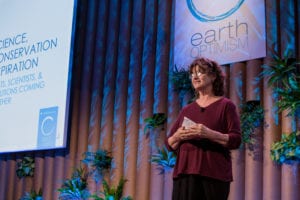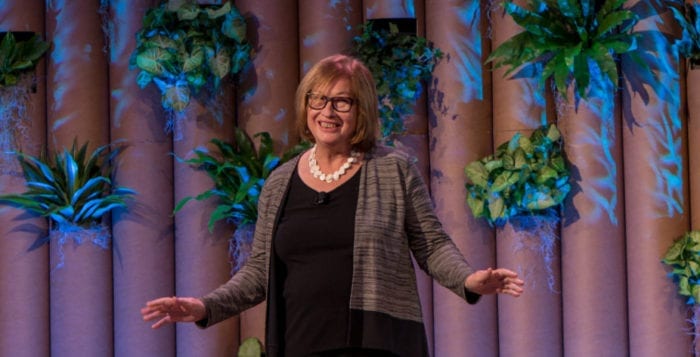By Daniel Dunaief
Determined to share success stories instead of doom and gloom, Nancy Knowlton, the Sant Chair of Marine Science at the Smithsonian Institution’s National Museum of Natural History, decided to change the tone of the conservation dialog.
Knowlton organized the first Earth Optimism Summit around the most recent Earth Day this April. She searched for speakers who could share their progress and blueprints for success. That included Patricia Wright, a Stony Brook University distinguished professor who has developed an impressive legacy during her 25 years in Madagascar.

In Madagascar, the 10th poorest country on Earth, optimism has been growing, perhaps even more rapidly than the 1,000 endemic trees that have been making a comeback in the island nation off the southeast coast of Africa. The growth of those trees has encouraged the return of animals that had retreated from an area thinned out by selective logging.
“This year, the rare and furtive bird, the scaly ground roller, came back and nested,” Wright reported. The “black and white ruffed lemur gave the area the thumbs up and reestablished territories and reproduced.”
The critically endangered golden bamboo lemur also doubled the size of its population. “The forest took 25 years to recover, but it can recover,” Wright said in her speech. Dedicated to the study of lemurs, Wright in 1991 helped create Ranomafana National Park, which is the third largest park in Madagascar. She served as a plenary speaker for a gathering that drew over 1,400 people to Washington. Scientists and policymakers held sister summits in nine other countries at the same time.
“You can’t possibly make progress in conservation if you only talk about the problems,” said Knowlton, a co-host of the summit. Knowlton knew Wright from serving on the Committee for Research and Exploration, where the two interacted six times a year. When she was putting together the list of speakers, Knowlton approached the 2014 winner of the Indianapolis Zoo Prize to see if she could share a positive message in conservation.
When Wright accepted, Knowlton was “thrilled, not only because she’s a good storyteller, but because she’s also done incredibly important work in Madagascar.” Indeed, Wright said national parks have greatly expanded from only two in the 1980s. “Now with the work of many dedicated environmentalists, including the enlightened policy of the U.S. government through USAID, we have 18 National Parks and a National Park Service to manage and protect them,” she told the session.
Restoring trees to the area also offers economic opportunity, Wright said. Under the endemic trees, farmers can grow crops like vanilla, chocolate, cinnamon and wild pepper, she said. “All these products can be marketed for high prices. We will take back that land and make it productive again, doubling or tripling its value,” Wright continued.
A scientist featured in the 2014 film “Island of Lemurs: Madagascar,” Wright has engaged in a wide range of efforts on behalf of the Malagasy. Last year, she negotiated with a mayor on the island to pick up trash in exchange for the purchase of several wheelbarrows. She also helped encourage the renovation of 35 schools in communities around Ranomafana, where students learn critical thinking and molecular biology. This, Wright said, is occurring in a country where three out of five students don’t remain in school past fifth grade. “More children in this region are graduating from high school and over a handful have received university degrees,” she explained.
A health team also walks to 50 nearby villages, carrying medicines and basic health lessons. SBU brought drones last year, which can fly medicines as far as 40 miles away. Drones could monitor the outbreak of any unknown and potentially dangerous disease and can offer health care for people who live in ares that are inaccessible by road.
The financial support of the National Science Foundation helped create Centre ValBio, a field station and campus in the middle of the rainforest. The research station has modern facilities and equipment to conduct genetics and disease analyses. “We provide tools and training and even fiber-optic cable internet, the fastest in the region,” Wright said. They are expanding the research facilities this year.
Through research efforts, Wright and other scientists have also discovered two new species of lemurs and found two others that were considered extinct. Restoring the national forest not only brought back animals that had retreated into the inner part of the forest, but it also encouraged the growth of ecotourism.
In 1991, there was only one tourist hotel and now there are 32 hotels, providing facilities for the 30,000 tourists. “That can start to change an economy,” Wright suggested. “Cottage industries have developed like the woman’s weaving group and the basket weavers and blacksmiths who all make a good living from selling to tourists and researchers.”
Wright attributes these positive steps to a dedication to working with residents in the area. “We have been successful by training local residents and university students, by listening to what the communities want, rather than what we think is best,” she said.
Knowlton suggested that “you can’t helicopter conservation into a particular place. It’s got to be built from the ground up. She’s done it in Madagascar.” While these are positive steps, Wright declared this is just the beginning. “There are endless possibilities of scientific knowledge and research,” she said. “They all matter and impact our daily lives.”
As for the Earth Optimism Summit, Knowlton said this is just the beginning as well, originally thinking of organizing a second summit in 2020, but may hold the next one sooner. “We’re identifying what’s working and putting a spotlight on it,” Knowlton said. “The feedback has been extraordinarily, unbelievably positive. We’ve come to realize that people are demanding” another conference.
She appreciated Wright’s contribution to April’s conference.“By sharing her successes, Pat Wright brings home the message that if she can do it, so can we all,” Knowlton said. “The summit succeeded because Wright and over 240 other speakers made it obvious, through the successes that they shared, that solving the environmental problems we face is not out of reach.”







